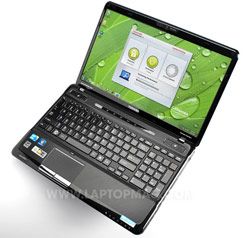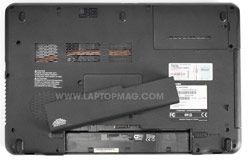Laptop Mag Verdict
This 16-inch machine delivers strong performance, great audio, and gaming-worthy graphics for a reasonable price.
Pros
- +
Fast Core i5 processor
- +
Good gaming frame rates for price
- +
Top-of-the-line speakers
- +
Can charge gadgets and play music in sleep mode
Cons
- -
Noisy keyboard and touchpad buttons
- -
Relatively short battery life
- -
Overly glossy screen
Why you can trust Laptop Mag
The 16-inch Toshiba Satellite A665-S6058 provides plenty of oomph for your cash. This notebook's Core i5 processor, Nvidia graphics, and excellent speakers make it well worth the $899 for entertainment seekers. While we definitely think there's some room for improvement here, the raw power of the A655 makes it worth a look.
Design
The lid and deck of the A665 have Toshiba's Fusion X2 matte finish, which up close looks like tiny chain links and doesn't leave fingerprints. The light gray touchpad, island-style keyboard, and touch-sensitive control bar all add to the device's distinctive look. However,some might prefer the ASUS N61Jv-X2, which has a 16-inch screen, a glossy lid with a pinstripe pattern, a silver speaker bar, and a rubberized palm rest.
The A665 measures 15 x 10 x 1.4 inches and weighs 5.8 pounds, so it can be a little hefty to carry in a messenger bag, but it fits comfortably in a laptop-optimized backpack. Then again, 16-inch notebooks are meant to be used primarily on a desk.
Keyboard and Touchpad
The A665 has an island-style keyboard that has a pleasant amount of space between keys. The keys offered good feedback but the layout was a bit noisy. We also don't like that the space bar is relatively small.
The 3.7 x 2-inch touchpad is big, highly sensitive, and supports multitouch gestures. Unfortunately, its location caused us to initiate gestures unintentionally; we often would accidentally zoom in using our finger and the edge of our palm. While the two discrete mouse buttons worked fine, they felt chintzy and were also noisy.

Click to enlarge
Heat
During testing, the Toshiba Satellite A665 was slightly below average in terms of heat. After streaming a Hulu video at full screen for 15 minutes, we measured the touchpad at 84 degrees, the middle of the keyboard at 85 degrees, the underside at 89 degrees, and the vent at 98 degrees. To put this in perspective, the average mainstream notebook comes in at 89 degrees for the touchpad, 92 degrees for the underside, and 96 by the vent.
Display and Sound

Click to enlarge
The Satellite A665's 16-inch, 1366x768 display looked sharp and colors popped when viewed head-on. However, the screen is a little too glossy for our liking, and images looked washed out when we viewed it from more than 30 degrees to the left or right of center. If you lower the brightness from the full level (perhaps to save battery life), you will likely see your reflection on the screen. When viewed head-on, every online video we watched in 720p (especially YouTube) looked great.
The Harmon/Kardon speakers above the keyboard are some of the best we've heard on a mainstream notebook. Both music and dialogue sounded excellent. When talking to a friend over Skype, her voice sounded clear and full, and we could even make out music playing in the background. We also listened to the second full-length album by Crystal Castles, an electronic act known for audio trickery. The song "Celestica" is a great test song, where strange computer-like noises come at you from left and right, as more traditional drumbeats and keyboards march along. The speakers here kept up and made clear distinctions between what was meant for each speaker.
Ports and Webcam
The Satellite A665 has a pretty standard mix of ports. The right side has two USB ports, headphone and mic jacks, a Kensington lock slot, and a DVD burner. The left side has another USB port, a combination eSATA/USB port, an HDMI-out port, an Ethernet port, and a VGA-out connector. The front lip of the laptop contains a 7-in-1 card reader.

Click to enlarge

Click to enlarge
Toshiba's USB ports allow Sleep and Charge, which allows you to charge USB devices even when the notebook is in standby mode. Also nice is the ability to listen to music with headphones through the 3.5mm audio jack or on the excellent speakers while the computer is asleep.
The VGA webcam on the A665 is decent, provided there's enough light. It had a hard time with dimly lit rooms and making appropriate exposure adjustments under stark florescent lighting. Under standard bulb lighting in a living room, it performed well and looked very smooth over a 10 Mbps Wi-Fi connection on Skype.
Performance

Click to enlarge
Thanks to its 2.4-GHz Intel Core i5-450M CPU and 4GB of RAM, the Satellite M645 turned in fairly strong scores. On PCMark Vantage, which measures overall system performance, the A665 scored 5,224, about 13 percent faster than the mainstream notebook category average of 4,551, but behind comparable machines such as the ASUS N61Jv-X2 (5,841), the Samsung R580 (5,804), and the Dell Studio 15 (5,735), all three of which have Core i5 processors.
The Satellite A665's 5,400 rpm 500GB hard drive took a slow 87 seconds to boot up Windows 7. The drive completed the LAPTOP File Transfer test, in which we copy 4.97GB of files, in an average 3 minutes and 39 seconds. That's a rate of 23.2 MBps, just below the category average of 23.5 MBps and well behind the Dell Studio 15's 28.3 MBps. You can choose a configuration of the Satellite A665 with a faster hard drive.
When transcoding video in Oxelon media encoder, the Satellite A665 showed off its processing power, as it took only 54 seconds to convert a 114MB MP4 to AVI format. That's eight seconds faster than the category average, and ever-so-slightly faster than the Samsung R580 (55 seconds) and Dell Studio 15 (57 seconds).
Graphics Performance
Before this year, consumers had to choose between buying a notebook with a discrete graphics chip that offered improved performance but less endurance, or one with an integrated graphics chip that consumed less power but didn't let them do as much. The Satellite A665 attempts to offer the best of both worlds by employing Nvidia Optimus, a technology that automatically switches between the Satellite's discrete GeForce GT330M GPU and an integrated Intel HD graphics chip based on which applications you are running. On all the graphics tests we performed, the system switched into discrete mode to provide strong graphics performance.
On 3DMark06, which measures overall graphics prowess, the A665 scored a whopping 7,002--more than double the category average of 3,378 and well ahead of the Samsung R580 (3,889), which has a Nvidia GeForce GT 310M card, and the Dell Studio 15 (3,654), which has an ATI Mobility Radeon HD 4570 GPU.
It's not being marketed as a gaming system, but the Toshiba A665 also has enough power to play 3D games. The laptop notched a whopping 178 frames per second in World of Warcraft at 1024 x 768 resolution and a still-strong 64 fps at its native 1366 x 768. That number is well above the category averages of 76 and 25 fps. On the much more demanding Far Cry 2, the A665 managed frame rates of 60 and 28 fps at 1024 x 768 and 1366 x 768 resolutions, respectively. Those numbers were ahead of the category averages of 32 and 16 fps, and no other similar notebook beats the A665's numbers in that realm.
Battery Life and Wi-Fi

Click to enlarge
Despite the fact that the Toshiba Satellite A665 uses Nvidia's Optimus technologgy, it didn't deliver good endurance. Our LAPTOP Battery Test, which consists of surfing the web continuously over Wi-Fi, yielded just two hours and 55 minutes, nearly two hours below the mainstream notebook average (those systems with 15-inch displays). The average desktop replacement lasts two hours and 47 minutes, which are notebooks with 17-18 screens. The A665 straddles those two categories, so its runtime isn't exactly poor. Still, the 16-inch ASUS N61Jv-X2 lasted 3:28.
The A665's Broadcom 802.11n radio turned in mixed Wi-Fi transfer rates relative to other laptops in its class. When we were 15 feet from the router, the A665 had better-than-average wireless strength, picking up a 43.6 Mbps transfer rate. When we were 50 feet from the router, the A665 had below-average scores, with a 19.7 Mbps transfer rate.
Configuration Options
The Toshiba Satellite A665 line from Toshiba comes in 13 configurations. The A665-S6058, the model we tested, is mid-range in terms of what specs are offered. The lowest-end A665-S6050 costs $791 and is powered a Core i3 processor and a basic Intel graphics chipset instead of the a Nvidia GeForce card. The top offering in this line is the $1,599 A665-3DVl; this notebook has a Core i7 processor, a GeForce tk graphics card, a 640GB hard drive, Blu-ray drive, and a 12-cell battery.
Software and Warranty
The A665 runs 64-bit Windows 7 Home Premium and comes with a good selection of Toshiba Utilities. The Toshiba Bulletin Board is arguably the most interesting of these because it allows the user to use a virtual board to make photos, calendars, sticky notes, and more available in one spot. The Toshiba DVD Player will enthuse movie fans with its ability to upscale regular DVDs to a higher resolution. There is also the very useful Eco Utility that lets you see how many watts of electricity your computer is using at any time.

Click to enlarge
The A665 comes standard with a one-year warranty on parts and labor. Read about how Toshiba did in our Tech Support Showdown here.
Verdict
The Toshiba Satellite A665-S6058 is a solid performer for its $899 asking price. Its internal components such as the Core i5 processor, 4GB of RAM, and Nvidia GPU with Optimus make it a strong performer, and its speakers deliver excellent audio. While the keyboard and touchpad buttons don't feel as good as they look, and the battery life isn't that high, the A665 is a multitimedia machine worth owning.
Toshiba Satellite A665-S6058 Specs
| Brand | Toshiba |
| CPU | 2.4-GHz Intel Core i5-450M |
| Card Slots | 8-1 card reader |
| Company Website | http://www.toshiba.com |
| Display Size | 16 |
| Graphics Card | NVIDIA GeForce GT330M |
| Hard Drive Size | 500GB |
| Hard Drive Speed | 5,400rpm |
| Hard Drive Type | SATA Hard Drive |
| Native Resolution | 1366x768 |
| Operating System | MS Windows 7 Home Premium (64-bit) |
| Optical Drive | DVD SuperMultiDrive |
| Optical Drive Speed | 8X |
| Ports (excluding USB) | Headphone, HDMI, Ethernet, eSATA/USB, VGA, Microphone |
| RAM | 4GB |
| RAM Upgradable to | 8GB |
| Size | 15 x 10 x 1.2 - 1.5 inches |
| Touchpad Size | 3.7 x 2 inches |
| USB Ports | 3 |
| Video Memory | 1GB |
| Warranty/Support | 1 year standard limited/24-7 toll free |
| Weight | 5.8 pounds |
| Wi-Fi | 802.11b/g/n |
| Wi-Fi Model | Realtek RTL8191SE |
